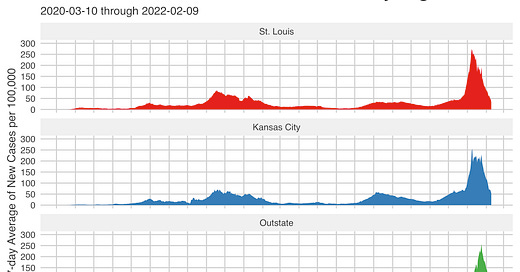As the Omicron surge continues to recede around the United States, everyone from state governors to local school district leadership is rethinking their use of nonpharmaceutical interventions (NPIs) like mask mandates. Locally in the St. Louis area, I’m told school districts are beginning to revisit their policies. However, there is not any sign so far that St. Louis City will imminently review its mandate. Meanwhile, many public health folks are sharply criticizing these moves as premature - removing protections too soon will only prolong rates of high cases.
Among the things I am looking for as we consider what protections are needed is an acknowledgment that whatever we take off now may need to come back later if (or perhaps when) we experience another surge. The approach I favor for removing and re-instituting NPIs is “data-driven” - using metrics including transmission, hospitalizations, and vaccinations to identify what types of interventions are (or are not) needed. Though the CDC is refusing to change the definition of “fully vaccinated” to include boosters, I think the smart move is to make that shift whether or not the CDC changes it officially.
Whatever we do, however, I think we need to acknowledge just how high transmission, hospitalizations, and mortality remain right now. Moreover, we need to grapple with how poor vaccination rates are in Missouri. And we also need to be realistic - most of Missouri will remain abandoned by local and state policymakers and complicit residents, who are indifferent to the preventable illness and death our neighbors are experiencing. - Chris
COVID-19 by the Numbers
Total cases in MO: 1,382,774 (+22,608 from last Thursday)
7-day average of new cases per day in MO: 3,229.71 (-3,820.57 from last Thursday)
Counties with the highest per capita rates (per 100,000) of new cases per day this past week:
Atchison (238.55 per 100,000), New Madrid (159.61), Scott (140.91), Mississippi (117.42), Putnam (115.71), Joplin (111.55), Holt (109), Grundy (103.88), and Dunklin (100.94)
Total deaths in MO: 18,191 (+384 from last Thursday)
7-day average of new deaths per day in MO: 54.86 (-11.14 from last Thursday)
Percent of all Missourians initiating vaccination: at least 58% (+1 percentage point increase from last week)
Percent of all Missourians completing vaccination: at least 52% (+1 percentage point increase from last week)
Case and mortality numbers are current as of Wednesday, February 9th. Vaccination numbers are current as of Thursday, February 10th. Additional statistics, maps, and plots are available on my COVID-19 tracking site.
Trends in the Past Week
At first blush, things look great. Look at the declines from our peak in early January - all three regions are well below where they were just a few months ago. St. Louis and Kansas City have dropped below their highs from November and December 2021. “Outstate” is lagging behind but still has experienced a significant drop. That said, our new case rates are comparable to our summer 2022 Delta surge. So, in that context, rates remain far higher than we would like to see.
The trends around Springfield capture the progress “Outstate” Missouri has made - steady declines from very high peaks towards the end of January. Notice how the trends tighten up on the right side of the plot. All eight counties in the region coalesce between 50 and 100 new cases per 100,000 residents per day this week. However, compare that to St. Louis City, and rates are still two or two-and-a-half times higher.
One county defying this trend is Atchison County in the extreme northwestern corner of Missouri. Unlike all of its neighbors and the most populous counties in Kansas City and St. Louis, Atchison is sustaining very high transmission rates.
The local hospitalization data we have is about ten days old. Still, we can see that we are not far removed from historic hospitalization rates in every metro except Cape Girardeau.
In St. Louis, where our data are more current, you can get a sense of the rapid improvement that I expect we’ll see in those other metro areas as well. Hospitalization numbers have been halved over the past four weeks or so. But, and this is critical, hospitalizations remain above their first wave and Delta wave levels. So, celebrate the massive release of pressure on our hospitals. At the same time, though, recognize that things are still worse than they have been for much of the pandemic.
One additional area where we have improved but things are still not great is pediatric hospitalizations, where we are seeing a slight resurgence over the past few days. This is incredibly disheartening for the 0-11 year-olds, where we know that vaccination rates are low and a portion of the group is not even eligible.
Finally, I want to highlight our mortality trends. Proportionally, we have seen fewer deaths during Omicron than we saw in prior surges. This trend fits with the generally milder nature of Omicron infections. I want to underscore that it is not mild for everyone, though. We saw mortality rates double our worst mortality from the Delta surge in St. Louis hospitals. Yes, hospitalization rates were more than double, but just the sheer number of our neighbors who have lost loved ones since Christmas is staggering.
The same trend appears to have played out at the state level, though we know much less about what the full extent is so far. From what we know, at least fifty Missourians died every day during mid-January.
So, as people debate removing masks and claim that now is the moment, remember that our rates of new cases are still very high relative to prior points in the pandemic, hospitalizations have improved dramatically but are still very high as well, and we are not far removed from a particularly deadly part of the pandemic. For those focused on kids, remember that our pediatric hospitalizations are starting to climb again. This may be temporary, but we owe it to our kids to prioritize their health.










